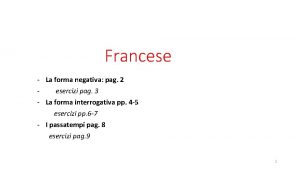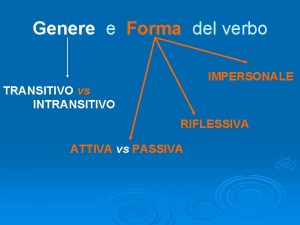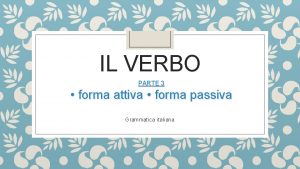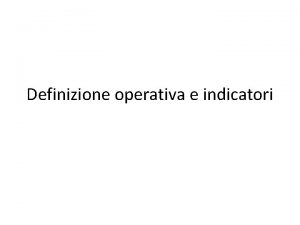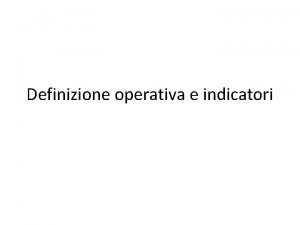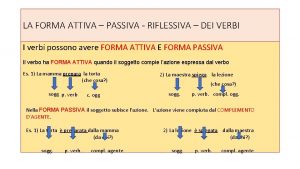Il passivo Definizione Si usa la forma passiva













- Slides: 13

Il passivo

Definizione Si usa la forma passiva quando il soggetto subisce l’azione invece di compierla. La frase attiva viene invertita e il complemento oggetto diventa il soggetto della frase: They always ask permission. (frase attiva) Permission is always asked. (frase passiva) Il passivo

Come si forma Verbo essere (al tempo richiesto) + participio passato del verbo principale AFFERMATIVA The bread is made fresh every morning. INTERROGATIVA Is the bread made fresh every morning? NEGATIVA The bread isn’t made fresh every mornng. INTERROGATIVA-NEGATIVA Isn’t the bread made fresh every morning? Il passivo

Come si forma nei diversi tempi ACTIVE PASSIVE (Present simple) They make it in Italy. It is made in Italy. (Present continuous) He is writing a book. A book is being written. (Future simple) They will send him an invitation. He will be sent an invitation. (Past simple) Somebody murdered him. He was murdered. (Going to) They are going to send a letter. A letter is going to be sent. (Past continuous) They were building a road. A road was being built. (Past perfect) They had called her. She had been called. (Present prefect) They have called a technician. A technician has been called. (Modal) They might hold a meeting. A meeting might be held. Il passivo

Quando si usa - 1 Per evidenziare un fatto o informazioni importanti: Further information will be given later! ⇩ L’enfasi è sull’informazione. Il passivo

Quando si usa - 2 Quando chi ha compiuto l’azione è sconosciuto: The car was stolen yesterday. ⇩ Non si sa chi l’abbia rubata. Il passivo

Quando si usa - 3 Chi compie l’azione non si menziona a meno che non sia considerato importante: The car is being repaired. ⇩ È ovviamente il meccanico. Il passivo

Quando si usa - 4 Se occorre specificare chi compie l’azione si deve usare by: A lot of damage was caused by high winds. ⇩ Chi ha causato il danno. Il passivo

Quando si usa - 5 Per dare disposizioni, istruzioni ed esprimere divieti: Fishing is not allowed. ⇩ Non è permesso. Il passivo

Altre forme - In frasi con think, consider, believe, say, report, know, find, ci sono due forme passive possibili: (active) People think he is writing a book. (passive 1) It is thought that he is writing a book. (passive 2) He is thought to be writing a book. (active) People say that he is brilliant. (passive 1) It is said that he is brilliant. (passive 2) He is said to be brilliant. Il passivo

Per esercitarsi Inserisci la forma e tempo appropriato del passivo. He ………………. . about the meeting. (not tell) ……. . … the class room ………………. . ? (paint) He …………. . …………… a gift tomorrow. (give) A new school ……. . ……………. at the moment. (build) The children …………… to bed early last night. (send) The chocolate …………. ! It’s finished! (eat) The house ………. . every day. (clean) She ……………. copying during the test yesterday. (catch) Il passivo

IT’S TELLY TIME! Il passivo

Mettiti alla prova! Cerca di riconoscere il passivo in un contesto reale! BBC Earth - Attenborough: the amazing Lyre Bird sings like a chainsaw https: //www. youtube. com/watch? v=m. SB 71 j. Nq-y. Q Il passivo
 Ativa e passiva
Ativa e passiva Forma attiva e passiva esercizi
Forma attiva e passiva esercizi Forfetírozás fogalma
Forfetírozás fogalma La forma passiva
La forma passiva Passive form inglese
Passive form inglese Forma attiva e passiva
Forma attiva e passiva Esercizi frase negativa francese
Esercizi frase negativa francese Verbo allontanare forma passiva
Verbo allontanare forma passiva Arszisz
Arszisz Grandinare forma passiva
Grandinare forma passiva Modo condizionale verbo amare
Modo condizionale verbo amare Transporte ativo exemplos
Transporte ativo exemplos Estoque é ativo ou passivo
Estoque é ativo ou passivo Esempio procedura ciclo passivo
Esempio procedura ciclo passivo






